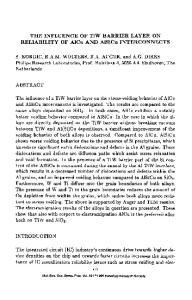Modeling of the Structure and Reliability of Near-Bamboo Interconnects
- PDF / 613,458 Bytes
- 14 Pages / 414.72 x 648 pts Page_size
- 22 Downloads / 367 Views
ABSTRACT
When interconnect feature sizes (e.g., widths) and grain sizes are comparable, their average electromigration-lifetime increases. However, reliabilityincrease occurs for a population of lines only if microstructural weak links, such as polygranular clusters, become unlikely throughout the population. Lifetime statistics and grain structure statistics are linked in a way which must be understood in order to take advantage of lifetime improvements through line-width-dependent and line-length-dependent current density limits. An analytic model has been developed which allows calculation of the polygranular cluster length distribution as a function of line width, line length and current density, given continuous-film median grain sizes and grain size deviations. A simple analytic model for the effect of post-patterning anneals on polygranular cluster length distributions is also presented. These models are shown to be consistent with detailed computer simulations of grain structures and grain structure evolution in interconnects.
Improved grain
structure models will enable less-conservative integrated circuit design practice, allowing design of higher performance circuits.
INTRODUCTION
When grain sizes and feature sizes are comparable, the reliability of metallization improves.
However, it also becomes very process-sensitive and very difficult to accurately
assess. In this regime, the statistics of reliability becomes directly linked to the statistics of the microstructure (grain size distributions, grain orientation distributions and the precipitate distributions). Multiple failure mechanisms become likely so that accurate reliability assessment requires knowledge of the failure characteristics, and the probability of occurrence of the mechanism leading to the earliest failures in large on-chip populations, at service conditions. 163 Mat. Res. Soc. Symp. Proc. Vol. 391 a 1995 Materials Research Society
When these can be accurately accounted for, interconnect and via reliability improvements characteristic of interconnects with bamboo and near-bamboo structures can be used in circuit design.
Less-conservative design rules and design practice made possible through a more detailed understanding of microstructure and reliability statistics can lead to higher performance integrated circuits. The focus of this paper is the use of computer simulations and analytic models to predict the distribution of polygranular and bamboo cluster lengths in interconnects. These will be described for lines patterned from polycrystalline films both with an without post-patterning annealing which leads to grain structure evolution. Given knowledge of the interconnect grain structures, electromigration models can be used to asses the reliability of large populations of interconnect line segments or vias. Among other things, this provides a means of assessing the suitability of test structures and whether the size of a test population is adequate for prediction of the reliability of actual in-service populations.
It also al
Data Loading...











